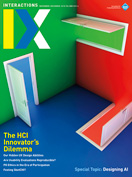Authors:
Martin Lindvall, Jesper Molin, Jonas Löwgren
From a human-centered perspective, one of the most important developments in the technical machine-learning (ML) domain is that learning algorithms can now improve their predictions when fed more training data. This means that processes and tools for generating training data, previously a matter mostly for one-off research projects, now have a large impact on the success of ML projects. In many domains, the designers and engineers of machine-learning-based systems do not themselves hold the expertise required to create training data. In a typical project, the creation and curation of data might require many man-months of effort and involve the…
You must be a member of SIGCHI, a subscriber to ACM's Digital Library, or an interactions subscriber to read the full text of this article.
GET ACCESS
Join ACM SIGCHIIn addition to all of the professional benefits of being a SIGCHI member, members get full access to interactions online content and receive the print version of the magazine bimonthly.
Subscribe to the ACM Digital Library
Get access to all interactions content online and the entire archive of ACM publications dating back to 1954. (Please check with your institution to see if it already has a subscription.)
Subscribe to interactions
Get full access to interactions online content and receive the print version of the magazine bimonthly.






